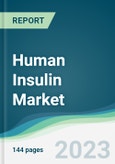Insulin is the hormone that controls sugar levels in the body. Diabetes is a chronic metabolic condition with an abnormal increase in blood glucose or sugar levels. Currently, it has two types. In type 1 diabetes, the pancreatic beta cells are unable to secrete insulin, whereas in type 2, the cells of the body become less sensitive to insulin secretion. With the increasing prevalence of sedentary lifestyles, the incidence of diabetes is anticipated to surge in the insulin market. In addition, favorable reimbursement trends in developed countries are expected to contribute to overall market growth.
Human Insulin Market Drivers
Rising cases of diabetes are contributing to the human insulin market growth
Diabetes is a chronic metabolic ailment that has been defined through increased blood glucose levels in the blood hypoglycemia. Humans have human insulin, which is widely used in individualized treatment, insulin replacement in clinical therapy, and specialty treatment to treat and control the disease. However, the demand for insulin is further propelled by the increasing consumption of the drug to treat type 1 diabetes, which controls blood sugar levels and prevents hyperglycemia by providing the essential insulin that does not form in the body. It is used orally and is designed to improve glucose uptake and increase the amount of insulin in the body.Further, the market is also expanding due to the increasing demand for insulin pump therapy products that provide a continuous flow of insulin all day, mimicking the basal insulin secretion by a healthy pancreas. In addition to that, human insulin is also very important in preventing high or low-glucose shifts in preoperative and critical care environments and, hence, is imperative in lessening surgical complications.
Human Insulin Market Geographical Outlook:
North America is witnessing exponential growth during the forecast period.The high prevalence of diabetes in North America, which is caused by a sedentary lifestyle, has resulted in the United States gaining a stranglehold on the global human insulin market. The cost factor is the biggest concern in the US since domestic insulin producers receive about half of their revenue. The United States accounts for most of the global sales of Lantus, a long-acting insulin. Many diabetes medication manufacturers view the country as a key market to boost global sales. Lantus is the most popular basal insulin worldwide and holds a monopoly on the US market.
Reasons for buying this report:
- Insightful Analysis: Gain detailed market insights covering major as well as emerging geographical regions, focusing on customer segments, government policies and socio-economic factors, consumer preferences, industry verticals, other sub-segments.
- Competitive Landscape: Understand the strategic maneuvers employed by key players globally to understand possible market penetration with the correct strategy.
- Market Drivers & Future Trends: Explore the dynamic factors and pivotal market trends and how they will shape up future market developments.
- Actionable Recommendations: Utilize the insights to exercise strategic decision to uncover new business streams and revenues in a dynamic environment.
- Caters to a Wide Audience: Beneficial and cost-effective for startups, research institutions, consultants, SMEs, and large enterprises.
What do businesses use our reports for?
Industry and Market Insights, Opportunity Assessment, Product Demand Forecasting, Market Entry Strategy, Geographical Expansion, Capital Investment Decisions, Regulatory Framework & Implications, New Product Development, Competitive IntelligenceReport Coverage:
- Historical data & forecasts from 2022 to 2030
- Growth Opportunities, Challenges, Supply Chain Outlook, Regulatory Framework, Customer Behaviour, and Trend Analysis
- Competitive Positioning, Strategies, and Market Share Analysis
- Revenue Growth and Forecast Assessment of segments and regions including countries
- Company Profiling (Strategies, Products, Financial Information, and Key Developments among others)
The human insulin market is segmented and analyzed as follows:
By Product Type
- Rapid-Acting Insulin
- Long-Acting Insulin
- Combination Insulin
- Biosimilar
- Others
By Application
- Type 1 Diabetes Mellitus
- Type 2 Diabetes Mellitus
By Distribution Channel
- Hospitals
- Retail Pharmacies
- Others
By Geography
- North America
- South America
- Europe
- Middle East and Africa
- Asia-Pacific
Table of Contents
Companies Mentioned
- Eli Lilly and Company
- Sanofi
- Novo Nordisk A/S
- Biocon
- Boehringer Ingelheim
- Tonghua Dongbao Pharmaceutical Co.
- Wockhardt
- Julphar
- Gan & Lee Pharmaceuticals
- Biocon
- Bioton
- Novo Nordisk Pharmatech
- Sigma-Aldrich
- CDH Fine Chemical
- BioGems
Table Information
| Report Attribute | Details |
|---|---|
| No. of Pages | 144 |
| Published | December 2024 |
| Forecast Period | 2025 - 2030 |
| Estimated Market Value ( USD | $ 23.33 Billion |
| Forecasted Market Value ( USD | $ 27.42 Billion |
| Compound Annual Growth Rate | 3.2% |
| Regions Covered | Global |
| No. of Companies Mentioned | 15 |









